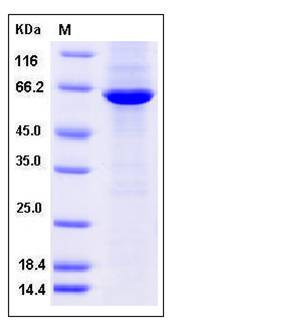Human CSF1R / MCSF Receptor / CD115 Protein (aa 543-922, His & GST Tag)
C-FMS,CD115,CSF-1R,CSFR,FIM2,FMS,HDLS,M-CSF-R,MCSF Receptor
- 100ug (NPP3773) Please inquiry
| Catalog Number | P10161-H20B2 |
|---|---|
| Organism Species | Human |
| Host | Baculovirus-Insect Cells |
| Synonyms | C-FMS,CD115,CSF-1R,CSFR,FIM2,FMS,HDLS,M-CSF-R,MCSF Receptor |
| Molecular Weight | The recombinant human CSF1R (aa 543-922) /GST chimera consists of 617 amino acids and has a calculated molecular mass of 71 KDa. It migrates as an approximately 60 KDa band in SDS-PAGE under reducing conditions. |
| predicted N | Met |
| SDS-PAGE |  |
| Purity | > 82 % as determined by SDS-PAGE |
| Protein Construction | A DNA sequence encoding the human CSF1R (NP_005202.2) cytoplasmic domain (Lys 543-Asp 922) was fused with the N-terminal polyhistidine-tagged GST tag at the N-terminus. A DNA sequence encoding the human CSF1R (NP_005202.2) cytoplasmic domain (Lys 543-Asp 922) was fused with the N-terminal polyhistidine-tagged GST tag at the N-terminus. |
| Bio-activity | Kinase activity untested |
| Research Area | Cancer |Oncoprotein & suppressor & biomarker |Oncoprotein |Growth Factor & Receptor |Receptor Tyrosine Kinase (RTK) |
| Formulation | Supplied as sterile 50mM Tris, 100mM NaCl, 20% gly, 0.3mM DTT, pH 8.0 1. Normally 5 % - 8 % trehalose and mannitol are added as protectants before lyophilization. Specific concentrations are included in the hardcopy of COA. |
| Background | M-CSFR encoded by the proto-oncogene c-fms is the receptor for colony stimulating factor 1 (CSF1R), a cytokine involved in the proliferation, differentiation, and activation of macrophages. This cell surface glycoprotein is consisted by an extracellular ligand-binding domain, a single membrane-spanning segment, and an intracellular tyrosine kinase domain. Binding of CSF1 activates the receptor kinase, leading to "autophosphorylation" of receptor subunits and the concomitant phosphorylation of a series of cellular proteins on tyrosine residues. CSF1R is a tyrosine kinase receptor that is absolutely required for macrophage differentiation and thus occupies a central role in hematopoiesis. CSF1 and its receptor (CSF1R, product of c-fms proto-oncogene) were initially implicated as essential for normal monocyte development as well as for trophoblastic implantation. This apparent role for CSF1/CSF1R in normal mammary gland development is very intriguing because this receptor/ligand pair has also been found to be important in the biology of breast cancer in which abnormal expression of CSF1 and its receptor correlates with tumor cell invasiveness and adverse clinical prognosis. Tumor cell expression of CSF1R is under the control of several steroid hormones (glucocorticoids and progestins) and the binding of several bHLH transcription factors, while tumor cell expression of CSF-1 appears to be regulated by other hormones, some of which are involved in normal lactogenic differentiation. However, studies have demonstrated that CSF1 and CSF1R have additional roles in mammary gland development during pregnancy and lactation. The role of CSF1 and CSF1R in normal and neoplastic mammary development that may elucidate potential relationships of growth factor-induced biological changes in the breast during pregnancy and tumor progression. |
| Reference |
